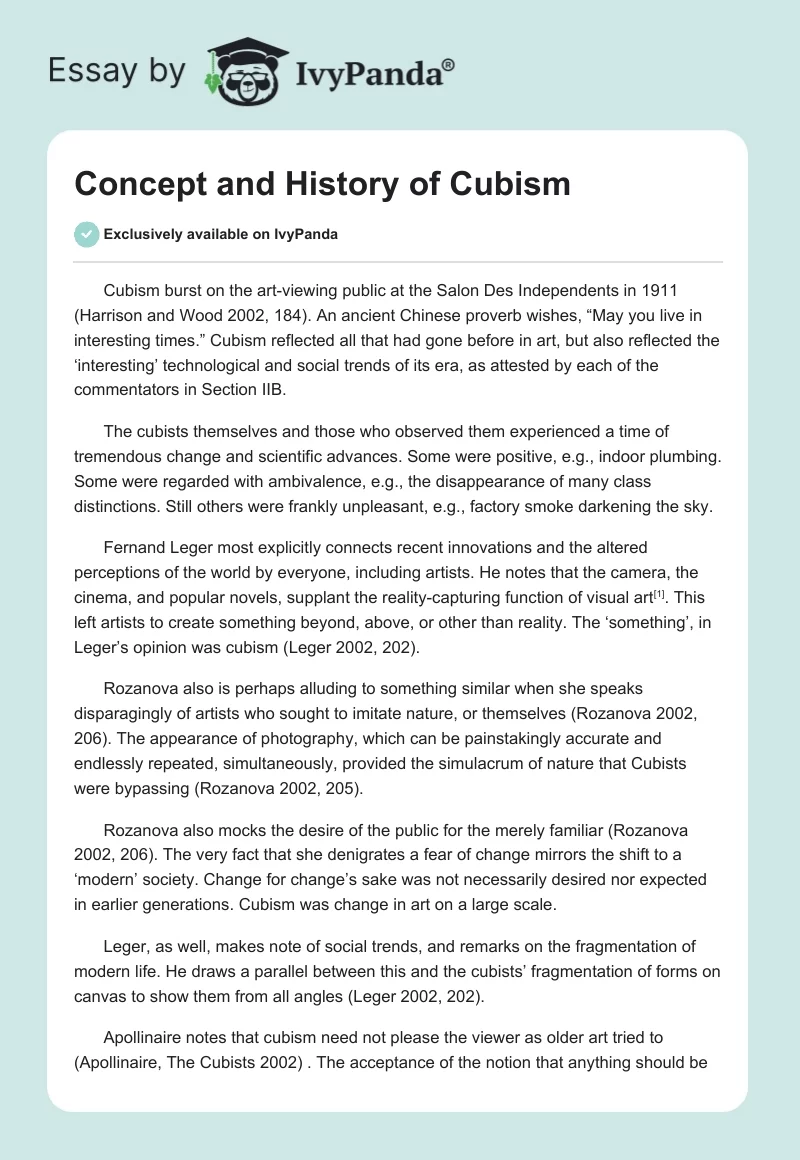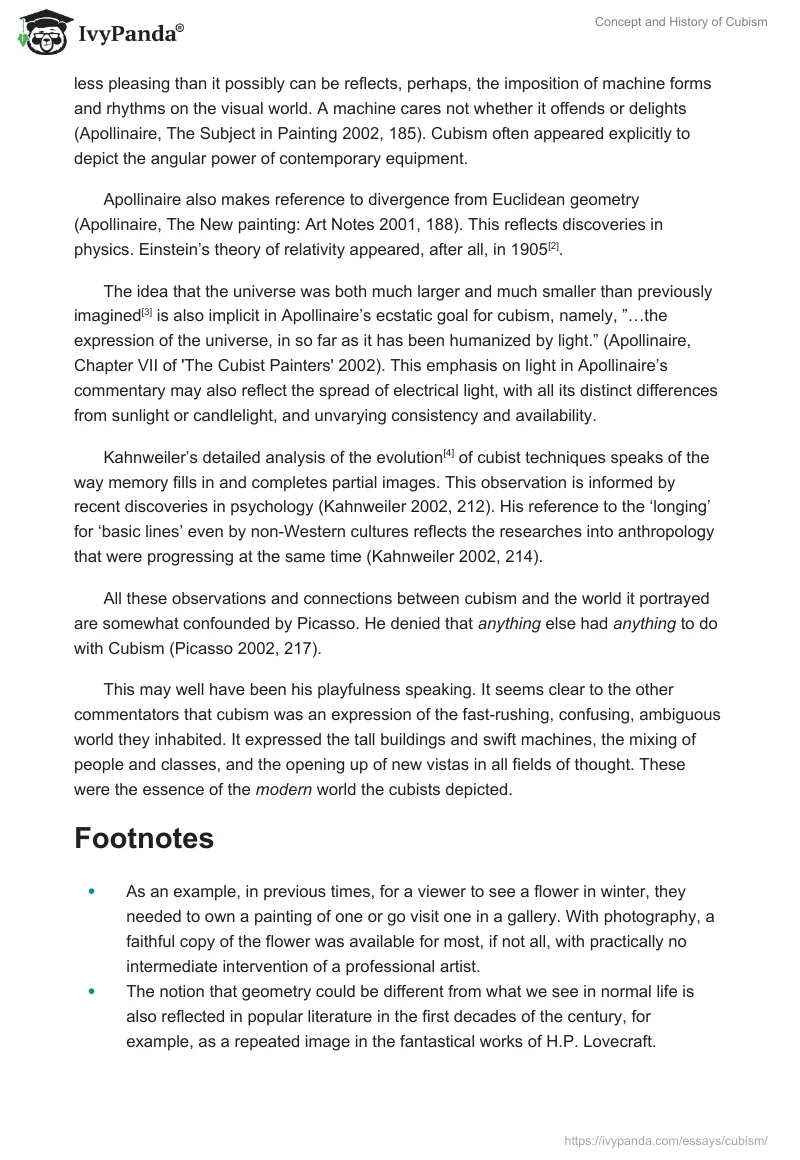Cubism burst on the art-viewing public at the Salon Des Independents in 1911 (Harrison and Wood 2002, 184). An ancient Chinese proverb wishes, “May you live in interesting times.” Cubism reflected all that had gone before in art, but also reflected the ‘interesting’ technological and social trends of its era, as attested by each of the commentators in Section IIB.
The cubists themselves and those who observed them experienced a time of tremendous change and scientific advances. Some were positive, e.g., indoor plumbing. Some were regarded with ambivalence, e.g., the disappearance of many class distinctions. Still others were frankly unpleasant, e.g., factory smoke darkening the sky.
Fernand Leger most explicitly connects recent innovations and the altered perceptions of the world by everyone, including artists. He notes that the camera, the cinema, and popular novels, supplant the reality-capturing function of visual art[1]. This left artists to create something beyond, above, or other than reality. The ‘something’, in Leger’s opinion was cubism (Leger 2002, 202).
Rozanova also is perhaps alluding to something similar when she speaks disparagingly of artists who sought to imitate nature, or themselves (Rozanova 2002, 206). The appearance of photography, which can be painstakingly accurate and endlessly repeated, simultaneously, provided the simulacrum of nature that Cubists were bypassing (Rozanova 2002, 205).
Rozanova also mocks the desire of the public for the merely familiar (Rozanova 2002, 206). The very fact that she denigrates a fear of change mirrors the shift to a ‘modern’ society. Change for change’s sake was not necessarily desired nor expected in earlier generations. Cubism was change in art on a large scale.
Leger, as well, makes note of social trends, and remarks on the fragmentation of modern life. He draws a parallel between this and the cubists’ fragmentation of forms on canvas to show them from all angles (Leger 2002, 202).
Apollinaire notes that cubism need not please the viewer as older art tried to (Apollinaire, The Cubists 2002) . The acceptance of the notion that anything should be less pleasing than it possibly can be reflects, perhaps, the imposition of machine forms and rhythms on the visual world. A machine cares not whether it offends or delights (Apollinaire, The Subject in Painting 2002, 185). Cubism often appeared explicitly to depict the angular power of contemporary equipment.
Apollinaire also makes reference to divergence from Euclidean geometry (Apollinaire, The New painting: Art Notes 2001, 188). This reflects discoveries in physics. Einstein’s theory of relativity appeared, after all, in 1905[2].
The idea that the universe was both much larger and much smaller than previously imagined[3] is also implicit in Apollinaire’s ecstatic goal for cubism, namely, ”…the expression of the universe, in so far as it has been humanized by light.” (Apollinaire, Chapter VII of ‘The Cubist Painters’ 2002). This emphasis on light in Apollinaire’s commentary may also reflect the spread of electrical light, with all its distinct differences from sunlight or candlelight, and unvarying consistency and availability.
Kahnweiler’s detailed analysis of the evolution[4] of cubist techniques speaks of the way memory fills in and completes partial images. This observation is informed by recent discoveries in psychology (Kahnweiler 2002, 212). His reference to the ‘longing’ for ‘basic lines’ even by non-Western cultures reflects the researches into anthropology that were progressing at the same time (Kahnweiler 2002, 214).
All these observations and connections between cubism and the world it portrayed are somewhat confounded by Picasso. He denied that anything else had anything to do with Cubism (Picasso 2002, 217).
This may well have been his playfulness speaking. It seems clear to the other commentators that cubism was an expression of the fast-rushing, confusing, ambiguous world they inhabited. It expressed the tall buildings and swift machines, the mixing of people and classes, and the opening up of new vistas in all fields of thought. These were the essence of the modern world the cubists depicted.
Footnotes
- As an example, in previous times, for a viewer to see a flower in winter, they needed to own a painting of one or go visit one in a gallery. With photography, a faithful copy of the flower was available for most, if not all, with practically no intermediate intervention of a professional artist.
- The notion that geometry could be different from what we see in normal life is also reflected in popular literature in the first decades of the century, for example, as a repeated image in the fantastical works of H.P. Lovecraft.
- Take as examples the tininess of atomic size and the unthinkable distances of galaxies.
- Evolution was a term that Picasso explicitly disavowed (Picasso 2002) with regard to his own Cubism.


